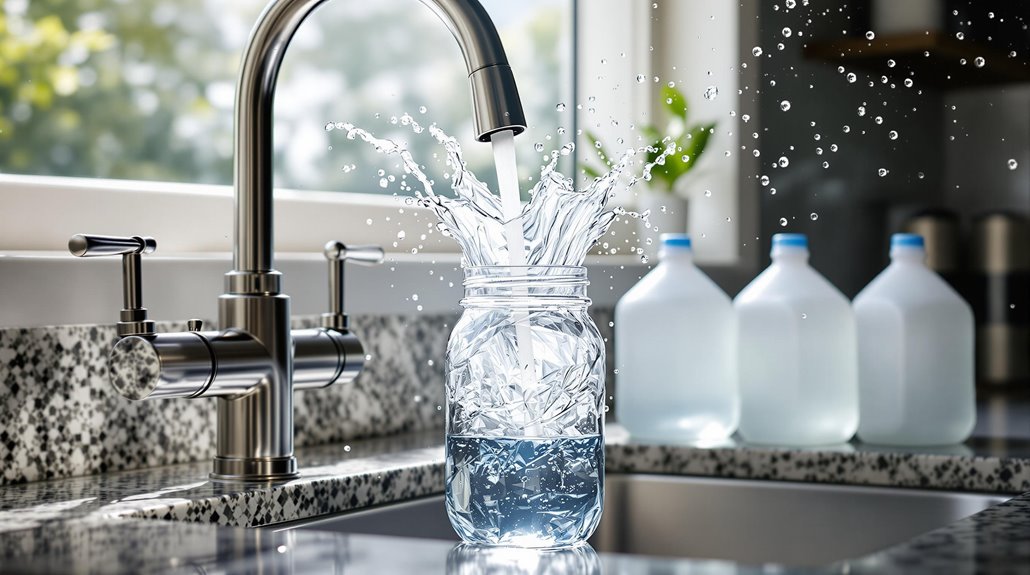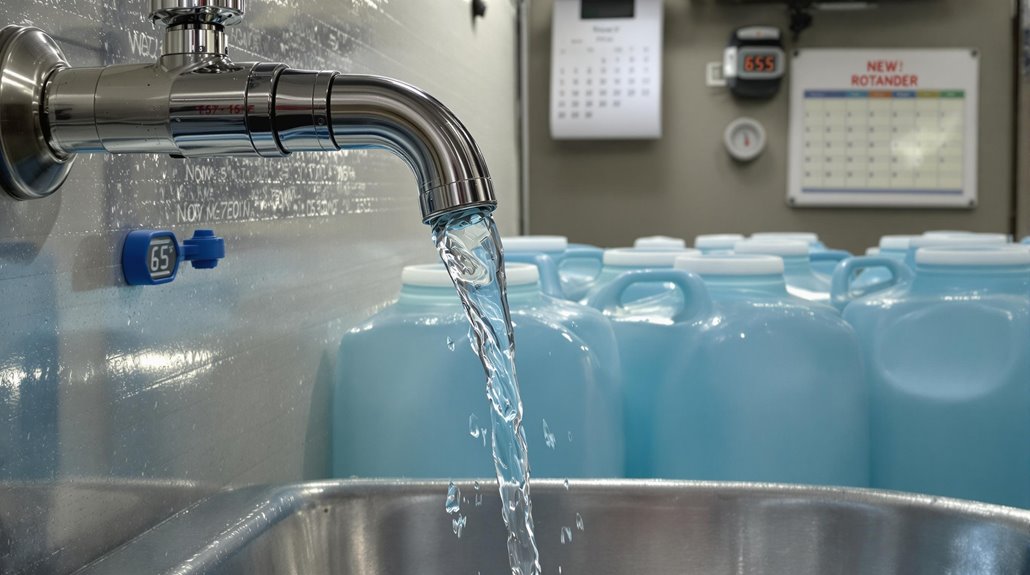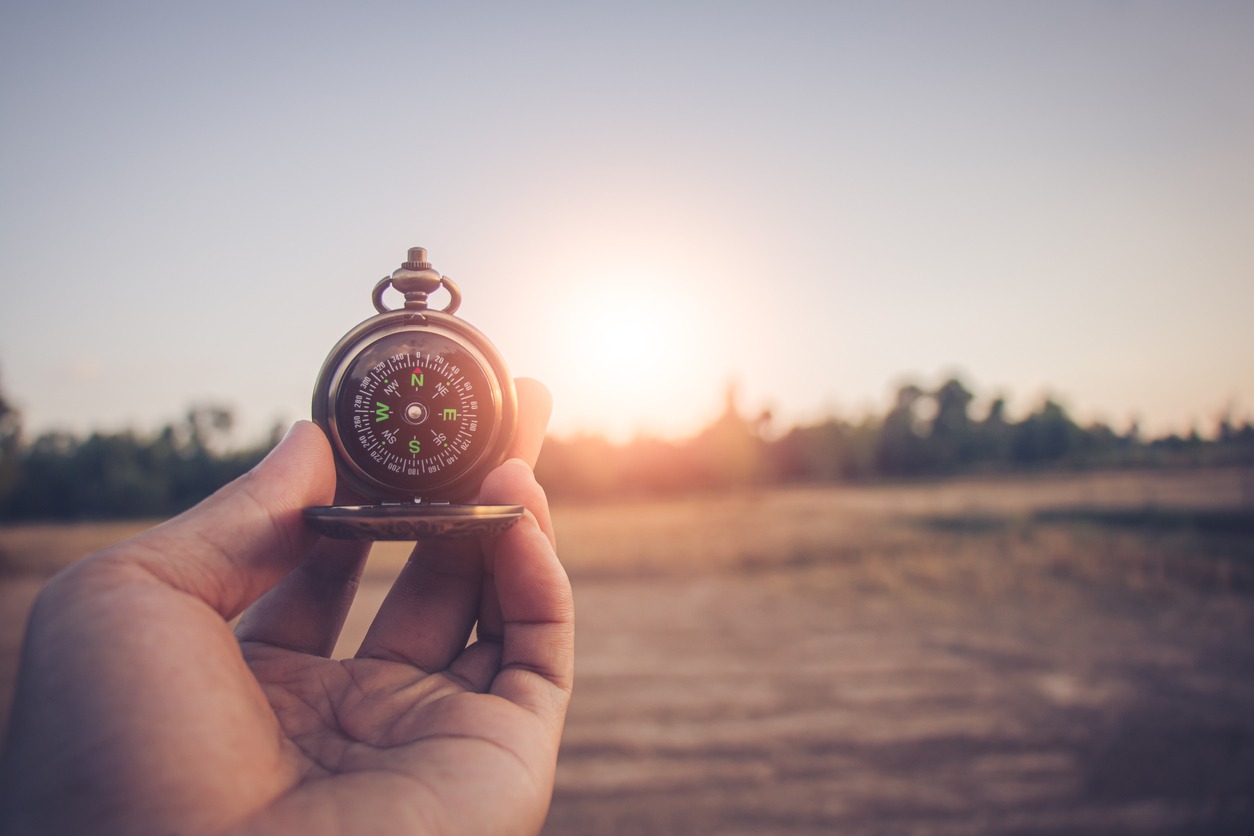What Is the First Rule of Prepping?

Water is your absolute first rule of prepping - you won't survive more than three days without it. You'll need to store at least one gallon per person per day, meaning 14 gallons for a two-week emergency supply. You should also invest in reliable water filtration systems and purification tablets as backups.
Start by evaluating your household's water needs and creating a proper storage system. There's much more to know about securing your water supply for survival scenarios.
Understanding Water as Your Foundation
The most fundamental rule of prepping begins with water - your lifeline during any emergency. You can't survive more than three days without it, making it your top priority in any preparedness plan. To guarantee your survival, you'll need to store at least 14 gallons per person for a two-week emergency supply.
Your water strategy shouldn't stop at storage. Invest in a reliable water filtration system and keep purification tablets on hand as backup. You'll want to learn essential skills for collecting and treating water from natural sources, as your stored supply may eventually run out. Make emergency preparedness easier by establishing a rotation system for your water storage, regularly checking for expired containers and maintaining cleanliness.
Remember, when it comes to prepping, water security forms the foundation of your survival strategy. Understanding proper water-borne illness prevention through sanitation practices is crucial for maintaining safe, drinkable water during emergencies.
Building Your Two-Week Water Supply
Once you've grasped water's essential role in survival, establishing your two-week supply becomes your next critical step. Before stocking up on food or first aid kits, calculate 14 gallons per person in your household. This guarantees you'll protect your loved ones during natural disasters or emergencies.
Store your water in food-grade containers, keeping them in a cool, dark area to prevent contamination. You'll need to regularly rotate your supply, using the oldest water first and refilling containers to maintain freshness. Don't forget to invest in a quality water filter - it's as indispensable as developing other survival skills.
Consider expanding your water security by setting up rainwater collection systems or maintaining a backup well. This multi-source approach strengthens your preparedness and increases your chances of long-term sustainability. Using two water tanks instead of one large tank provides a reliable backup system while rotating your supply.
Water Storage Methods and Best Practices

Proper water storage methods can mean the difference between thriving and struggling during an emergency. Your survival guide should prioritize water storage as a vital component of your emergency kit. Store at least one gallon per person daily for two weeks using food-grade containers that won't contaminate your supply.
Keep your water safe and fresh with these essential steps:
- Choose glass, stainless steel, or food-grade plastic containers to prevent chemical leaching
- Add unscented household chlorine bleach to prevent bacteria and algae growth
- Replace stored water every 6-12 months, checking containers for damage
Don't forget to include a reliable water purification system in your preparations. Whether you choose a portable filter or gravity-fed system, having multiple ways to guarantee clean water is essential for long-term survival. Avoid storing water containers directly on concrete floors, as this can lead to chemical contamination of your water supply.
Water Purification Systems and Techniques
Building upon your water storage plan, you'll need reliable methods to purify additional water when supplies run low. For optimal survival preparedness, invest in a gravity-fed filter or high-quality water purification system as your primary solution. These devices are essential first aid tools during an emergency.
Solar disinfection methods can effectively purify water using only sunlight exposure for about 6 hours. You've got several backup options to guarantee safe drinking water. Boiling remains effective but requires a heat source, while water purification tablets offer a portable solution for quick disinfection.
To strengthen your emergency skills, learn how to safely collect and clean water from natural sources like streams and rainwater. Remember, no single method is perfect, so it's smart to combine multiple purification techniques. Keep both stored water and purification tools ready - this two-pronged approach will help you maintain a reliable water supply during any crisis.
Emergency Water Sources and Collection

When disaster strikes, identifying reliable emergency water sources becomes indispensable for long-term survival. While you'll need to eat and maintain enough food and first aid supplies, water remains your top priority when you plan your emergency response.
- Store at least one gallon per person daily for three days, but aim for a two-week supply to guarantee access to medical care during extended emergencies
- Set up rain barrels or collection systems to capture precipitation, which can supplement your stored water supply
- Keep portable water filters or purification devices ready to make untreated water safe for consumption
Store your water in food-grade containers away from sunlight and heat. Practice accessing and rotating your supplies regularly. Remember, water preparation is just as pivotal as stockpiling enough food and maintaining first aid supplies.
Creating a Water Security Action Plan
A detailed water security action plan forms the backbone of your survival preparations. First, calculate your household's daily water needs ahead of time, including drinking, cooking, hygiene, and pets. The most important thing is identifying multiple water sources near your location - both primary and backup options.
Common sense dictates creating a three-tiered system: immediate access (stored water), secondary sources (rainwater collection, nearby streams), and emergency alternatives (hidden caches, filtration equipment). You'll need to map out water collection routes and maintain a rotation schedule for stored supplies.
Keep your plan flexible and review it seasonally - water sources can change throughout the year. Having this structured approach to water security gives you peace of mind while ensuring your family's survival during emergencies.
Maintaining and Rotating Water Reserves

Maintaining your water reserves requires a systematic approach to certify a safe, reliable supply during emergencies. Just like food items on your prepper checklist, water needs regular rotation to confirm it stays fresh and potable. You'll be better prepared by following these essential steps:
- Inspect your stored water containers monthly for signs of damage, leaks, or contamination
- Label each container with two different dates: the filling date and the next rotation date
- Replace stored water every six months, even if you include items like purification tablets
Store your water in food-grade containers and keep them in a cool, dark place away from direct sunlight. Remember to maintain at least 14 gallons per person for a two-week emergency supply, and regularly test your filtration systems to validate they're functioning properly when needed.
Common Water Storage Mistakes to Avoid
Three critical mistakes can derail even the most diligent water storage plans. First, you'll compromise your First Rule Of Prepping by storing water containers directly on concrete, which can leach chemicals into your supply. Second, you're making an imperative error if you don't develop the skills necessary to properly treat and filter water from a wide range of sources.
Finally, failing to store water containers in easily accessible locations defeats the purpose of prepping as a lifestyle choice, since you'll need to access them at a moments notice during emergencies. To avoid these pitfalls, use wooden pallets under containers, learn multiple purification methods, and create a logical storage system that allows quick access while protecting your water from light and temperature fluctuations.




